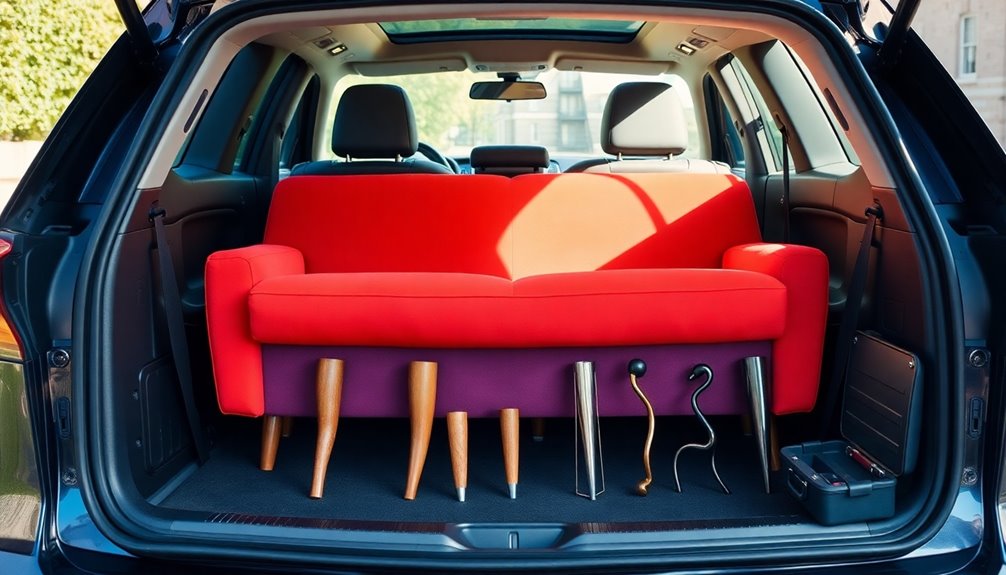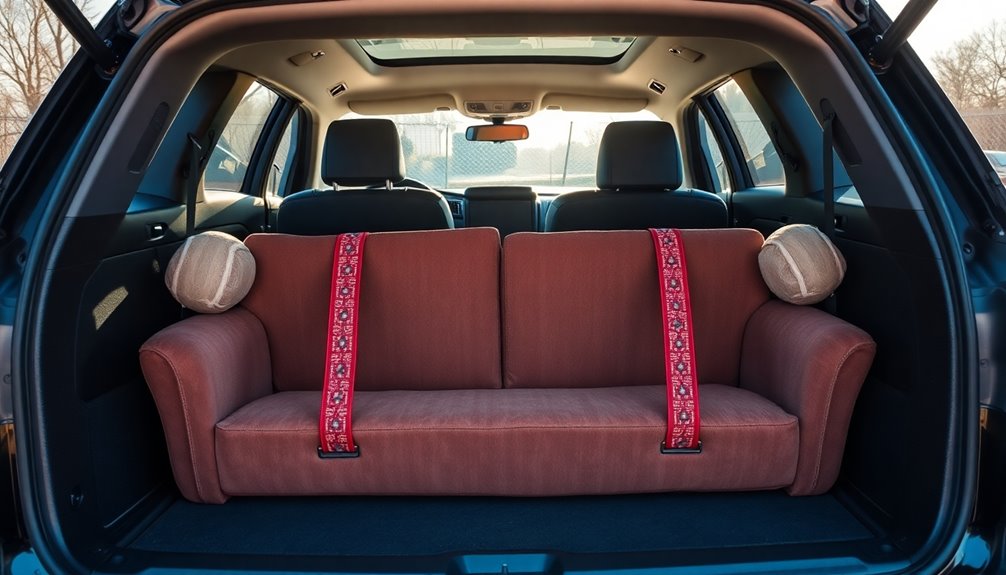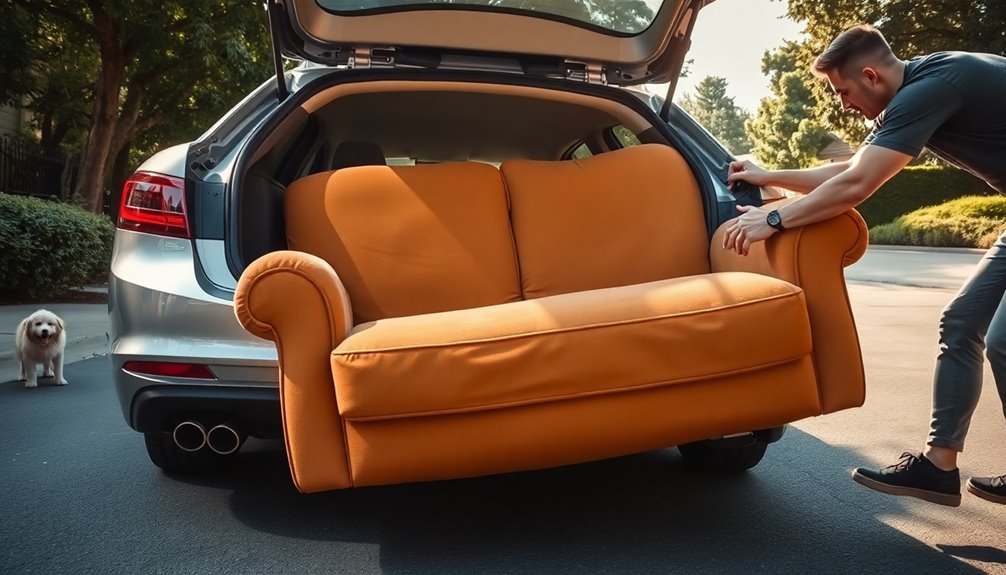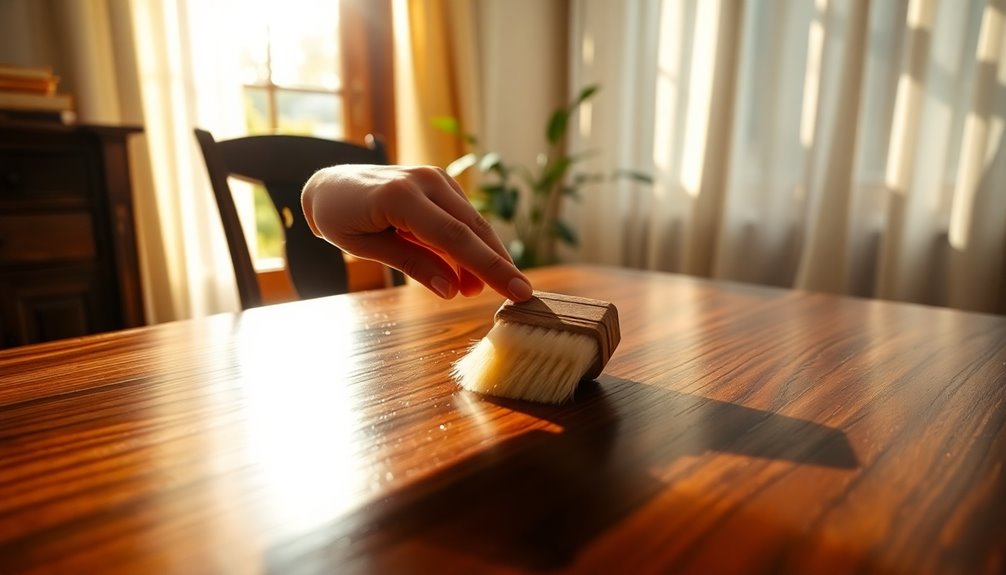To transport a sofa in your car, start by disassembling it into smaller sections for easier handling. Measure your sofa to ensure it fits inside. Wrap each piece in moving blankets and secure them with plastic wrap to protect against scratches. Use furniture sliders or a dolly to lighten the load while loading and unloading. Secure the sofa tightly in the vehicle to prevent movement during transit, and avoid overloading it to protect the frame. By taking these steps, you'll ensure a smoother transport experience, and there's more valuable info to help you with the process ahead.
Key Takeaways
- Disassemble the sofa into smaller parts to ensure it fits comfortably inside your vehicle.
- Measure the sofa and vehicle dimensions to confirm compatibility before loading.
- Wrap the sofa in moving blankets and secure with plastic wrap to prevent scratches.
- Use furniture sliders or dollies to assist with loading and unloading safely.
- Secure the sofa tightly in the vehicle to prevent movement during transit.
Introduction

When you transport a sofa, protecting its fabric is crucial to maintaining its appearance. You'll want to use routine fabric protection treatments and specific cleaning techniques to keep it looking fresh. If accidents happen, like a red wine spill, knowing how to treat those stains can save your sofa from lasting damage.
Routine Fabric Protection Treatments
Many homeowners overlook the importance of routine fabric protection treatments for their sofas, but these treatments can significantly enhance the longevity and appearance of your furniture. By applying a fabric protector, you create a barrier against stains, dirt, and spills, which helps maintain your sofa's fresh look. This barrier also reduces the absorption of liquids, making it easier to clean up accidents and preventing permanent damage to the upholstery.
It's essential to choose a fabric protector that's safe for household use. Many options contain non-toxic chemicals, ensuring safety for pets and children. Regularly scheduled treatments, ideally every 6-12 months, can boost the effectiveness of the protection, keeping your sofa looking new for longer.
When you transport a couch, remember that the fabric can be vulnerable to damage during the move. Having a protective treatment can minimize the risk of stains incurred while loading and unloading. Always follow the manufacturer's instructions for application and reapplication to ensure optimal results. This way, you protect the fabric without causing discoloration or damage, giving your sofa the best chance to remain in excellent condition.
Fabric-Specific Cleaning Techniques
Understanding the right cleaning techniques for your sofa's fabric is crucial for maintaining its appearance and longevity. Different upholstery materials require specific methods to ensure effective cleaning without causing damage. Always check the manufacturer's care label for fabric-specific instructions; some materials might be dry clean only or need professional care.
For cotton upholstery, a mild detergent mixed with water works well, while leather needs a specialized cleaner to avoid deterioration. If your sofa is made from synthetic fibers like polyester, a simple vinegar and water solution can effectively tackle stains without harming the fabric.
Natural fabrics, such as linen, require a gentler approach, often needing delicate cleaning solutions and air drying to prevent shrinkage or warping. Before using any cleaning product, it's smart to test it on a hidden area of the fabric first. This way, you can ensure that it won't cause discoloration or damage when applied to more visible spots. By following these fabric-specific cleaning techniques, you'll keep your sofa looking great for years to come.
Treating Red Wine Spills
Red wine spills can quickly become a nightmare for your sofa, but acting fast can save the day. The key to handling these mishaps is to treat the stain as soon as it happens. Start by gently blotting the spill with a clean cloth or paper towel to absorb the excess liquid. Avoid rubbing, as that can spread the stain further.
Next, mix white vinegar and dish soap in a 3:1 ratio, and apply this solution directly to the stain. Let it sit for a few minutes before blotting it up. If the stain proves stubborn, sprinkle some salt on the spill to absorb the wine, then vacuum it after a few minutes.
Once you've treated the stain, rinse the area with cold water to eliminate any cleaning agents. Finally, blot the area dry with a clean towel to prevent lingering moisture from setting the stain. By following these steps, you'll not only protect your sofa but also avoid the hassle of needing to move a couch to hide the damage. If you act quickly, you can help keep your furniture looking its best.
Sofa Stain-Resistant Treatments

When protecting your sofa from stains, consider scratch-resistant fabric choices and stylish fabric covers that not only enhance appearance but also add durability. You might also want to explore using durable fabric options designed to withstand daily wear and tear. By making the right selections, you can keep your sofa looking great for years to come.
Scratch-Resistant Fabric Choices
How can you ensure your sofa withstands the rigors of daily life? Choosing the right fabric is key. Look for scratch-resistant options like microfiber, which stands up to daily wear and tear while keeping a clean appearance. Synthetic fibers such as nylon and polyester offer exceptional strength and resilience compared to natural fibers, making them ideal choices for busy households.
Additionally, consider fabrics with tight weaves, like canvas or denim. These materials provide enhanced durability against scratches, perfect for high-traffic areas in your home. If you have pets or kids, opt for sofas labeled as "pet-friendly" or "family-friendly." These typically feature both scratch-resistant and stain-resistant qualities for added longevity.
Before moving your sofa, protect it with moving blankets to prevent scratches during transport. By selecting the right fabric and using proper protective measures, you can ensure your sofa remains in great condition despite the challenges of everyday life. With these considerations in mind, you'll not only enjoy your sofa's beauty but also its durability for years to come. Additionally, integrating smart home devices can help monitor the environment and maintain optimal conditions for your furniture.
Employing Stylish Fabric Covers
If you want to keep your sofa looking pristine, employing stylish fabric covers treated with stain-resistant solutions is a smart choice. These covers can be treated with effective stain-resistant treatments like Teflon or Scotchgard, which create a protective barrier against spills and stains while maintaining the aesthetic appeal of your furniture.
These treatments repel liquids, preventing them from soaking into the fabric, making cleanup a breeze. With versatile options available for various fabrics, including cotton and polyester blends, you can find stylish covers that suit your home decor.
Regular maintenance, such as vacuuming and spot cleaning, will enhance the effectiveness of these stain-resistant treatments, prolonging the life of your fabric cover. Investing in these stylish covers can significantly reduce the risk of damage from everyday use, making them ideal for homes with children or pets.
Using Durable Fabric Options
Choosing durable fabric options for your sofa can make a significant difference in maintaining its appearance and longevity. When selecting your sofa, consider materials like microfiber and synthetic blends, which are inherently stain-resistant and much easier to clean than natural fibers. These durable fabric options are perfect for busy households and can withstand everyday wear and tear.
Additionally, you might want to look into stain-resistant treatments like Teflon or Scotchgard. These treatments create a protective barrier that repels spills, making it simpler to keep your sofa looking fresh. Fabrics labeled as "performance" or "high-performance" are specifically designed to resist fading and hold up in high-traffic areas, making them ideal for families. Best Purple Shampoos for Brassy Tones can also be useful in maintaining the color vibrancy of your upholstery.
Don't forget that regular cleaning and maintenance are essential. Using specialized upholstery cleaners can enhance the longevity of your stain-resistant fabrics and help maintain their protective qualities. When purchasing, inquire about the specific stain-resistant treatments used, as their effectiveness can vary against different types of stains. By choosing wisely, you'll ensure your sofa remains a beautiful centerpiece in your home for years to come.
Upholstery Stitching and Patching

When you're transporting a sofa, you might notice issues with frame stability, leather conditioning, or cushion softness. Addressing these concerns through proper upholstery stitching and patching can make a big difference. You can ensure your sofa stays in great shape for years by using the right techniques and materials.
Frame Stability Concerns
Transporting a sofa requires careful attention to frame stability, as any movement during transit can lead to significant damage. Make sure the frame is secured tightly to prevent any shifts that could stress the upholstery stitching. Before you hit the road, inspect the upholstery for any weaknesses, like frayed stitching or loose patches. If you find any, reinforce them with fabric glue or stitching to minimize risks during transport.
Using moving blankets and plastic wrap can further cushion both the frame and upholstery, adding protection against impacts that might compromise stitching integrity. If you're disassembling the sofa, label and secure the frame components properly to avoid misalignment when you reassemble it. Misalignment can cause undue stress on the frame, ultimately affecting the upholstery.
Also, avoid overloading your vehicle. Excessive weight can apply pressure on both the frame and stitching, risking structural damage or compromised upholstery. By ensuring frame stability and taking these precautions, you can protect your sofa during transport and keep it in great condition for years to come.
Leather Conditioning Treatments
After ensuring your sofa's frame is stable and secure, it's important to focus on the leather upholstery. Leather conditioning treatments are essential for maintaining the suppleness and longevity of your leather sofa. These treatments prevent drying and cracking by replenishing the natural oils lost over time. You should aim to condition your leather every 6 to 12 months to significantly extend its lifespan and enhance its appearance, restoring its original sheen and color.
While you're at it, check the upholstery stitching. Loose or frayed stitches compromise the structural integrity of your sofa, so repair them promptly to avoid further damage. If you find cuts or tears, patching is a reliable solution. Use a suitable leather patch and adhesive, ensuring the color and texture match for a seamless repair.
When purchasing a leather conditioner, opt for a professional-grade product that's pH-balanced and free of harsh chemicals to avoid discoloration or damage. Taking these steps not only preserves your sofa's beauty but also makes it easier for professional movers to handle your piece when it's time to transport it.
Cushion Softness Enhancement
Cushion softness enhancement plays a vital role in maintaining the comfort and longevity of your sofa. Effective upholstery stitching is essential for keeping your couch cushions shaped and structured, preventing them from sagging over time. When you notice any wear or damage, patching can restore those areas, ensuring that your cushions remain both comfortable and visually appealing while extending their lifespan.
Using high-quality materials, like memory foam or high-density foam, during patching or restitching can significantly improve overall softness and support. It's important to follow the manufacturer's weight limit for your couch, as exceeding it can lead to faster deterioration of the cushions.
Regular maintenance is key; fluffing and rotating cushions helps redistribute the filling, preventing permanent indentations from frequent use. Additionally, professional upholsterers often recommend double-stitched seams for added durability. This technique not only enhances the cushion's lifespan but also helps retain softness by preventing seams from splitting under pressure. By keeping these tips in mind, you can enjoy a soft, comfortable couch for years to come.
Sofa Leg Replacement Options

Replacing sofa legs can significantly enhance both the aesthetic and functionality of your furniture. When you consider a sofa leg replacement, think about the height and style of the new legs to ensure they complement your sofa's design. Standard options include wooden, metal, or plastic legs, with heights typically ranging from 3 to 6 inches, depending on your sofa's configuration.
Before you start, check if your sofa has threaded inserts for easy leg replacement. If not, you may need to disassemble the couch and drill additional holes or use leg plates for secure attachment. Adjustable legs are a great choice if you want to customize the height and stability, especially on uneven flooring.
It's crucial to match the weight capacity of the new legs with your sofa's overall weight. This helps prevent potential damage or instability during use. By carefully selecting the right legs, you can ensure your sofa not only looks good but also remains safe and functional for years to come. So, take the time to explore your options before making a decision.
Routine Maintenance for Longevity

To keep your sofa in great shape for years, regular maintenance is essential. Start by inspecting your sofa frequently for any loose screws or bolts. Tightening these can prevent structural issues and ensure stability during a move. Next, clean the upholstery and surfaces using appropriate cleaners. This helps maintain the fabric's integrity and prevents deterioration from dirt or stains.
Rotating the cushions periodically is another smart move. This ensures even wear and prolongs their lifespan, which is especially important to avoid damage from uneven pressure during transport. Additionally, consider applying protective treatments like fabric protectors or leather conditioners. These shields help safeguard the materials from wear and tear, particularly if you're moving the sofa often. It's also beneficial to understand energy-efficient options for maintaining a comfortable environment, as this can protect your sofa from extreme conditions.
Finally, storing your sofa in a climate-controlled environment is crucial. Extreme temperatures or humidity can significantly affect the durability of the materials. By following these maintenance tips, you'll not only enhance the longevity of your sofa but also keep it looking great, making your move much smoother. Regular care is a small investment for a big payoff in comfort and style!
Conclusion

Maintaining your sofa not only enhances its longevity but also makes transporting it much easier when the time comes. When you're moving, taking the time to prepare can save you a lot of stress. Start by disassembling your sofa into smaller parts; this significantly eases the loading process and helps make sure it fits inside your vehicle. Always measure your sofa and the car's interior dimensions to confirm compatibility, avoiding any last-minute surprises.
Protect your sofa from scratches and damage by wrapping it in moving blankets, then securing it with plastic wrap. This simple step can prevent costly repairs later. To reduce strain on your back, use furniture sliders or dollies during the loading and unloading process.
If your sofa doesn't fit inside your car, don't worry! Consider using roof racks for transport. Just ensure it's securely fastened with ratchet straps to prevent any shifting while you drive. By following these tips, you'll make moving your sofa a hassle-free experience. With the right preparation and protective measures, you can transport your sofa safely and efficiently, allowing you to focus on enjoying your new space.
Frequently Asked Questions
Can You Transport a Couch in a Car?
Yes, you can transport a couch in a car, but it depends on the size of both the couch and your vehicle. You'll want to measure the couch and your car's interior first. If it's too big, try disassembling it or angling it diagonally. Don't forget to protect it with blankets to prevent scratches. If it still won't fit, you might need to secure it on the roof, ensuring it's safe and within weight limits.
How to Secure a Sofa in a Car?
To secure a sofa in your car, use high-quality ratchet straps for better strength and stability. Fasten the straps across the width and from front to back, ensuring it won't shift during transit. After loading, check for any signs of movement and adjust the straps as needed. If possible, transport the sofa upside down for easier securing. Don't forget to inspect strap tightness during stops to keep everything secure throughout your journey.
How to Transport a 3 Seater Sofa?
To transport a 3-seater sofa, start by measuring both the sofa and your vehicle to ensure they'll fit. Disassemble any removable parts, like legs and cushions, to make it easier to maneuver. Wrap the sofa in moving blankets for protection, then use furniture sliders or a dolly to lift it. Secure the sofa inside with ratchet straps or bungee cords, and drive carefully to avoid any shifting during transit.
How Do People Transport Couches?
When you're moving a couch, you'll often disassemble it for easier handling. Start by removing cushions and legs. Using furniture sliders or a dolly can make the process smoother, too. Make sure to measure both the couch and the vehicle to avoid surprises later. Finally, secure the couch with ratchet straps for safety, and wrap it in moving blankets to protect it from scratches during transport. You'll appreciate the extra care!









